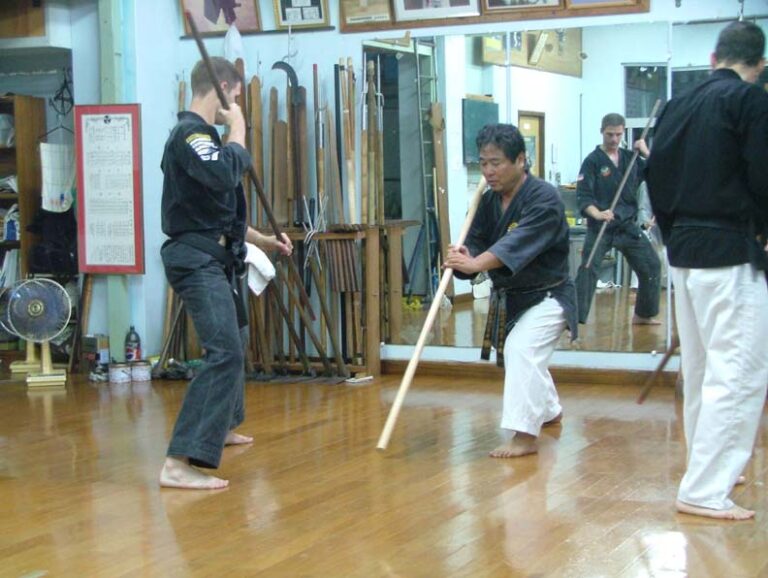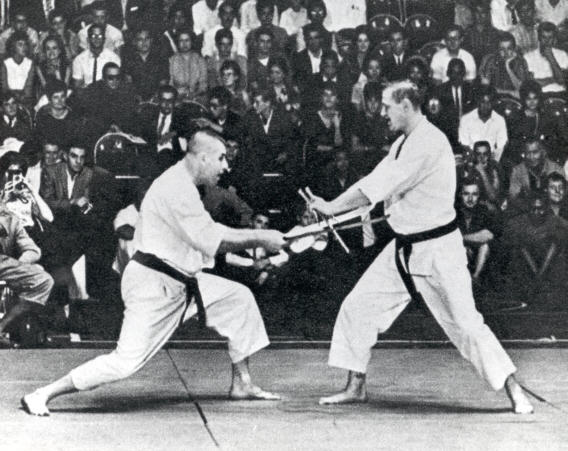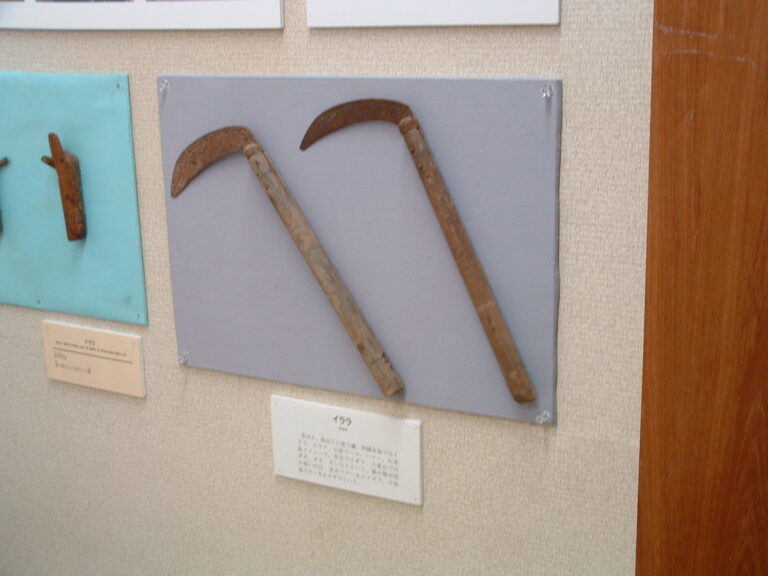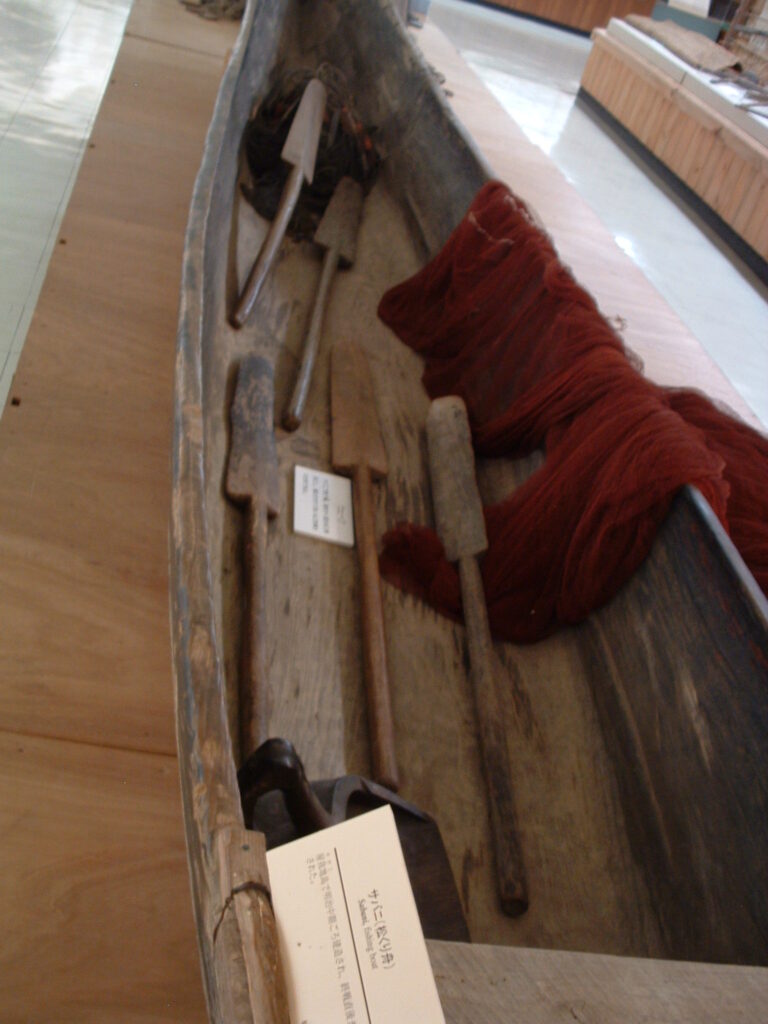Kobudo is the Okinawan martial art of weapons. These include the bo (staff), eiku (oar), kama (sickle), nunchaku (tonfa), tonfa (side-arm baton), and sai (iron truncheon). In Japan, many Okinawan martial artists were hired to perform in ninja and samurai movies, while in the American action movies many practitioners of Okinawan Kobudo were hired as actors, and stunt coordinators. Even the famous nunchaku, worked by Bruce Lee, is a weapon found Okinawan Kobudo. In reality, many of these weapons are unique to Okinawa and originally were not practiced by ninja, samurai, or Chinese martial artists at all.
The difference between Okinawan Weapons and those found in mainland Japan, is that in Okinawa weapons such as the sword, spear, bow & arrow, and musket were completely forbidden. However, the local people still needed to defend themselves against armed bandits, thugs, pirates, and cannibals. So they took simple farm implements and tools such as wooden staffs, boat oars, sickles, rice thrashers, mill stone handles, iron truncheons and other items and developed them into deadly weapons. The martial artists practicing Kobudo became so adept at this that the casual observer may not even realize that the weapon he is seeing has its origins in such a utilitarian function. It is not an uncommon sight in Japan to see an old lady weeding her garden with a kama!
History
By 1314, Okinawa was divided into 3 kingdoms, all of which were vying for trading rights with China, Japan, and other Southeast Asian neighbors. In 1372 a permanent Chinese settlement was established in Kume, Okinawa. In 1429 the king of Okinawa’s Central Kingdom, Sho Hashi, defeated the kings of both the Northern and Southern Okinawan Kingdoms, unifying the island. The city of Shuri was established as the new capital. To prevent future uprisings, all weapons on the island were prohibited. This began a period of peacefulness and prosperity for the island, and it became the primary trading hub between China, Japan, and Southeast Asia.
However, the people of the island still needed a way to defend themselves against local thugs, bandits, pirates patrolling shipping routes, and uncivilized tribes from southern islands that often raided remote villages. Having no access to swords or firearms, the people of Okinawa focused on training to fight using nothing but their hands and feet as weapons. For inspiration, they looked to the Chinese systems of martial arts, originated in the Shaolin Temple by Taishi Daruma, which had been introduced to Okinawa by the Chinese settlers living in Kume. These were combined with the rigorous training methods of the native fighting arts of “Ti”. The result it what we now know as Karate.
In extreme situations, the Okinawan people would resort to using various farming implements to defend themselves. These everyday implements such as wooden staffs, boat oars, sickles, rice thrashers, mill stone handles, iron truncheons and other items they found on hand, were turned into weapons in the hands of a skilled martial artist and became the origin of the bo, eiku, kama, nunchaku, tonfa, and sai. These martial arts are collectively known as Kobudo, and are is closely related to Karate.
Many of the techniques and weapons found in Okinawan Kobudo are unique to this martial art. However, much like Karate practitioners, they also looked for inspiration to the Chinese martial arts. However, many of the weapons commonly used in China were simply unavailable and illegal in Okinawa. So many of the Chinese techniques were modified for use with the available Okinawan farming implements. Some aspects of Japanese martial arts were incorporated as well, however the Satsuma Clan from Southern Japan invaded Okinawa in 1609 and subsequently the Okinawan people suffered many hardships under their occupation. It is not uncommon to find that Okinawan Kobudo techniques are frequently designed to be used against the samurai sword, the favorite weapon of the Japanese. There are many famous legends in Okinawa about famous Kobudo practitioners defending themselves, their family, and community against overzealous samurai.
TYPICAL WEAPONS OF KOBUDO
Bo (6′ Staff): The bo is a 6′ staff made of oak or other hardwood. Historically, it could be made from any stick found on hand, and easily turned into a deadly weapon. Blocks, strikes, and thrusts could easily disable an attacker. A skilled practitioner could even use its length to keep a sword-wielding attacker at bay.

Sai (Truncheon):

Tonfa (Side-Handled Baton): Originally used as a mill-stone handle, the tonfa could easily be grabbed and used to defend yourself in case anyone invaded your house. It proved to be such an effective self-defense weapon that it was selected to be standard issue to American police forces.

Nunchaku (Flail): The origin of this weapon is usually credited as a rice flail, but there were very similar devices used as horse bridals, and also a night-watchmen’s clapper in medieval Japan. Although difficult to master, this weapon can be a very effective tool for personal self-defense. With a swinging strike it can easily render an assailant unconscious, and it is also extremely effective as for joint locking and chocking techniques. Because of its effectiveness, it has been outlawed in several countries and states including Canada, Russia, Germany California, Arizona, New York, and even Hong Kong.
This weapons was popularized by Bruce Lee in the 1960s & 1970s, as it was predominantly featured in several of his movies. However, Lee learned how to use this weapon from a practitioner of Okinawan Kobudo, not from his Chinese instructors.
Kama (Sickle): Originally, the kama was a tool used for trimming grass and harvesting sugar cane. Even today, it is a common Japanese gardening tool and is used just as commonly as shears. It is typically used in pairs. Blocks, cuts, slashes, stabs and strikes with the weapon are very similar to karate techniques. Because of its difficulty to master this is considered an advanced weapon, as a beginner could easily hurt themselves during training.

Eiku / Kai (Oar): The Eiku was based on the oar. Historically, much of Okinawa’s economy was based on fishing and trade, which made this a handy tool for self defense. Many of the techniques are similar to the bo, however the blade of the oar is used for slashing and slapping movements.

